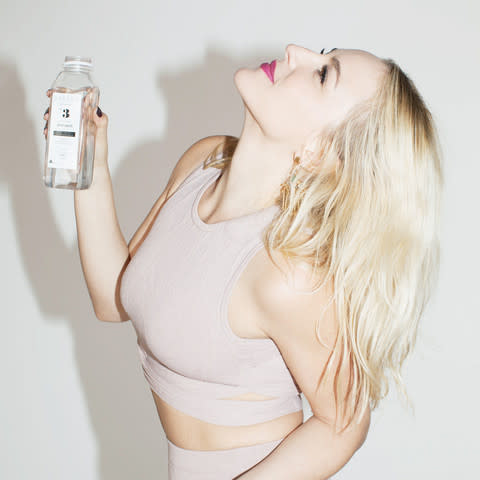Would You Spend $6 on a Bottle of Beauty Water?

The Sakara Life Beauty water contains “a blend of spring water, 72 trace minerals, silica and organic rose oil.” (Photo: Sakara Life)
How much would you spend on a bottle of water if it claimed to make your skin glow from inside out? Is it worth $6 to you? Vegetarian meal delivery service Sakara Life is selling Beauty Water (4 bottles for $24), which is composed of alkaline water, silica, and rosewater. Business Insider recently tried Sakara Life’s $109-a-day diet reportedly touted by Victoria’s Secret Angels, which included a batch of the Beauty Water. The silica “makes your water wetter so your cells actually uptake more water,” co-founder Danielle DuBoise told the publication. Gawker mocked the claim: “A good diet is one that drains you both physically and spiritually,” wrote Hamilton Nolan. But anyone who has watched Bill Nye the Science Guy as a child knows that you can make water “wetter,” in a way: if you add soap to water, the surface tension is reduced, which allows for sponges to soak up water more efficiently and is why you can’t float in sudsy water. But do silica and body cells work the same way as soap and sponges? Silica gel, a.k.a. those packets you find in your shoeboxes and newly purchased handbags, is used to prevent molding by absorbing moisture in the air — but that doesn’t necessarily mean your body functions the same way.
“We don’t know if the silica or other trace minerals will go through the digestive tract all the way to the skin cells,” chemist Joel Studebaker, PhD, explains to Yahoo Beauty. “For example, Gatorade provides electrolytes which really do replenish your body, but silica is not an electrolyte.” He is skeptical about any supplements that make claims without explaining their mechanisms. A representative from Sakara Life tells Yahoo Beauty that the Sakara Life Beauty Water contains “a blend of spring water, 72 trace minerals, silica, and organic rose oil.” Indeed, there are clinical studies that have shown that silica can help increase bone density and is essential for bone and connective tissue health, especially as one ages. One study from 2007 notes that “very little toxicity data exist regarding aqueous silica consumption due, in part, to the lack of anecdotal reports of toxicity and general presumption of safety,” but noted that rodents who consumed 50,000 ppm (mg/L) of dietary silica have benefited from the compound, the second most prevalent element after oxygen. However, Sakara Life doesn’t specify how much silica is in the Beauty Water, or what the mechanisms for absorption are — a mechanism that the medical community has yet to study on humans, either. Though silica is absorbed through the gastrointestinal tract, there is, so far, poor evidence to explain its relationship with excretion, metabolism, and absorption. Another medical study from 2007 notes that most mineral waters already contain significant amounts of silica.
The Sakara Life Beauty Water tastes distinctly of rosewater, which is one trait you won’t find in most mineral waters in the supermarket, no matter how high-end, but that doesn’t mean it’s better for you. “Our skin is naturally dry for a reason,” biology textbook author Anita Chetty tells Yahoo Beauty. “It has evolved this way in order for us to survive in harsh, terrestrial environments.” It’s true that hydration comes from within, not from external sources, but you’re not going to find an anti-aging remedy from drinking more water: “Wrinkles are created not from lack of hydration but from loss of elasticity as collagen fibers break down as part of the aging process,” Chetty explains. But if the clinical trials are right, more silica in your diet can boost your collagen elasticity. It’s up to you to decide whether $6 per bottle of water is worth it while you await the results from the scientific community, though.
Related:
Water World: What To Know About the Most Prevalent Skincare Ingredient
